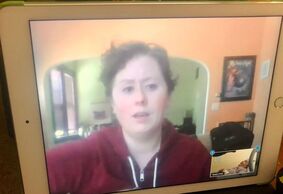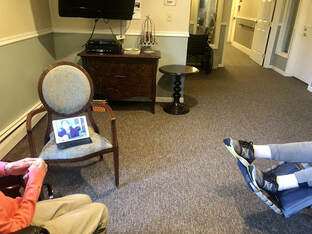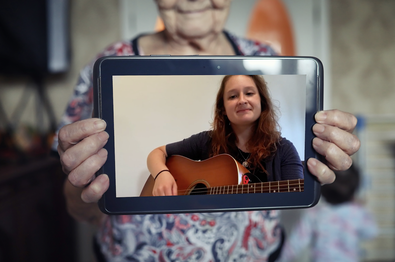|
As we approach the one-year anniversary of COVID-19 here in Minnesota, we wanted to do a special feature on our elderly community, who have been significantly impacted by the pandemic. During this past year, our seniors have especially felt the emotional, mental, spiritual and physical impact from isolation and the trauma of so many layers of loss. Through these unimaginable challenges, music therapists have had the incredible privilege of navigating new ways of providing connection and support through music through virtual telehealth formats, and under layers of PPE. We are excited to share stories from two incredible music therapists, Megan Druckrey and McKenna Selissen, who have a great passion for working with older adults in our community. Megan Druckrey, MT-BCMusic Therapist at Allina Hospice (MN)  I've been a hospice music therapist working in the Twin Cities since 2007. When the pandemic first hit and everyone was scrambling to figure out how we were going to make music therapy sessions continue, I admit that I was very skeptical about the efficacy of Telehealth to deliver the power of music therapy. Weeks went by with phone calls to clients, families, and facilities trying to figure out how to proceed. During this time, our clients who were already isolated due to declining health were now facing a deeper level of isolation when friends and families could no longer pay them in-person visits. Ten months later, there are still many facilities that are not letting in families and support staff. I went into my first Telehealth session with a patient feeling uneasy about my ability to connect via the computer. With the help of a hospice nurse assisting the connection, we soon experienced the power of music therapy when my patient's scowl melted into a beautiful smile, a relaxed affect, and a look of relief when she saw my familiar face and heard her favorite song. We could connect!  Even though Telehealth is not the ideal way of practicing music therapy, I have learned over the many months that it is absolutely beneficial to the patients we can’t see in person yet. An added bonus of having Telehealth is that the clients can see our actual faces and mouths! I’ve been told that it's a welcome “look” to see my full face, even if it’s on my computer. Some special moments I have in Telehealth sessions have included connecting the patient and spouse in a group music therapy session since family is not allowed at the facility, tailoring music therapy to reduce pain perception, and providing live music therapy support to a patient who is actively dying at a facility that doesn’t allow visitors. I’ve also had the privilege of providing special music for patients and families who are only allowed to have virtual funerals and memorial services. The element of live (virtual), supportive music has enhanced the depth and intimacy of these end-of-life rituals which are so important for the bereft. Even though we music therapists can’t always be in-person to serve our clients and patients, with the help of Telehealth therapy, we can at least reach each other in these trying times and provide support in the best way we know how! I’m longing for the time where we can all be together in person safely, but until then, we care. McKenna Selissen, MT-BCMusic Therapist at Twin Cities Music Therapy Services  Over the past few months during the Covid-19 pandemic, I have had the privilege of working with adults in long term care facilities through Virtual Music Therapy Sessions. Throughout this time, long term care facilities have been hit the hardest with COVID-19. The inevitable strict visitor restrictions and daily precautions to keep these individuals safe, have also caused many adults to feel isolated, lonely, and anxious. Their loved ones and other important visitors are no longer able to come in and they are often quarantined in their rooms when outbreaks occur. In addition, if they are able to leave their rooms, they are limited as to what they can do with other residents in the same facility. Virtual music therapy sessions have provided a way to connect, improve mood and promote movement and relaxation during this difficult time of isolation. During these virtual music therapy sessions, I have been fortunate to meet some of the most incredible individuals. Twice a week I see two small groups as well as several residents for 1:1 sessions. Our small virtual music therapy groups provide a way for those that attend, to socialize with one another (even if it’s distanced), it creates opportunities for them to make their own choices throughout the session, as well as a way to express themselves in the group. During our 1:1 sessions, the goals are similar. These sessions are focused on what each individual client needs in that particular moment. This could be playing a song that reminds them of their loved ones, having them choose a song that reflects how they’re feeling or just a song they want to hear that day, playing a compilation of songs to help them feel more relaxed, or simply getting to know one another during a time when connecting with others is so incredibly difficult. Many times, music therapy sessions are some of the only interactions they have with others outside of their facility since the pandemic began. Virtual music therapy has made it possible to connect and bring joy to these residents during a time of isolation and struggle.
1 Comment
|
About the AuthorsOur blog posts are written by our staff and guest authors who have a perspective on or related to Music Therapy that we value, and hope you will too. Archives
August 2022
Categories |
Copyright 2022 Twin Cities Music Therapy Services, LLC

 RSS Feed
RSS Feed